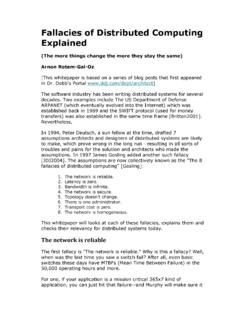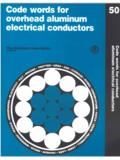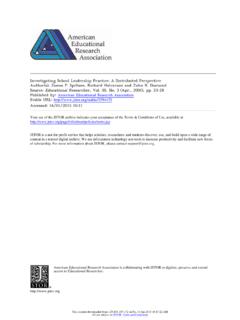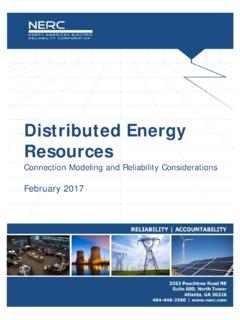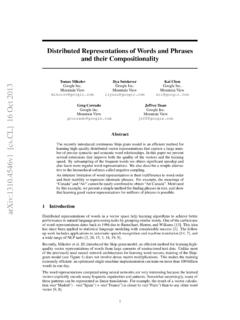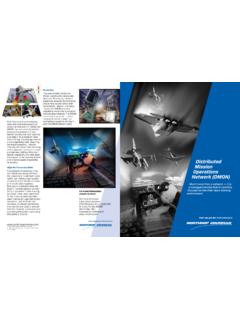Transcription of DISTRIBUTED BY: Ui. S. DEPARTM~ENT OF …
1 AD-755 827 HEAT AGEING OF RUBBERSA. L. StokoeE~xplosives Research and Development EstablishmentWaltham Abbey, EnglandMarch 1972 DISTRIBUTED BY:National Technical Information ServiceUi. S. DEPARTM~ENT OF COMMERCE5285 Part Royal R~oad, Springfield Va. 22151 EROE TR 91 ERDE TR 91 MINISTRY OF DEFENCE"4 EXPLOSIVES RESEARCH=AND DEVELOPMENT ESTABLISHMENTTECHNICAL REPORT No. 91 Heat, Ageing of RubbersA L StokoeReproduced byNATIONAL TECHNICALINFORMATION SERVICEU S Deportment oi CommerceSpringfield VA 22151 WALTHAM ABBEY U-MarchESSEX 1972 MIIV7RY OF DEFENCEE-PLOSrJES RESEARCH AND DEnMOP IT ESTABLISMNTT echnical Report No 91 March 1972 Heat Ageing of RubberebyA L StokoeSUMYThe oven ageing behaviour of six rubbers ( , polychloro-prene, FVC/nitrile, fluorocarbon, EPDM and natural), in theform of tensile dumb-bells has been measured and attempts havebeen made to relate the ageing behaviour to conventional rateprooesses.
2 By fitting to an empirical equation the change ofelongation at break the prediction of shelf storage life atambient temperature car be made for all the rubbers except thefluorinated rubber (Viton).!Further copies of this technical report can be obtained from Defence Re3earchInformation Centre, Station Square House, St Mary Cray, Orpington, 3 REiIL/CONTE1 NTSPage 14o1 Introduction 12 Experimiental 22 1 Materials 22 2 Heat Ageing 23 Results 24, Conclusions 65 aeferences 6 Appendix: mlastomer Compositions 7 Tables 5 -10 10 -15 Figures 1 -9 Reference: WAC/213/033I INTRODUCTIONIt is often necessary to predict the safe storage period or working life of arubber component at the design or pre-production stage.
3 The most commonlyaccepted way of doing this is to perform accelerated ageing trials on eitherthe component or a test sheet of the same composition in the chosen environ-ment at hiGher temperatures and fitting the results where possible to anArrhenius expression:k (rate of change) = A exp (-F/RT)where E = activation energy *f the ageing processT = absolute temperatureR = gas constantDifficulty is often experienced in fitting the results for rubbers to such anequation. This is hardly surprising due to the complex chemical nature of arubber vulcanizate.
4 Other factors which add co the difficulty of forecastinga realistic life are:a manner and environment in which rubber is used,,b thickness of rubber,c presence or absence of and ozone,d rate of' diffusion of all degredants (gaseous, liquid or solid),e ingredients of mix and post vulcanization residues, andf type of crosslinc systemOne of the mo"t universal tests used is that of accelerated ageing in a celloven whore rubber samples, usually dumb-bells, are suspended in a free flowof air at various temperatures for different periods of time. Propertiesmeasured are tensile strength, elongation at break, modulus and results and knowledge of the effects of the variables listed previously,together with previous experience of the ageing of similar materials,usually allows a reasonable estimate of the safe storage or working life tobe made.
5 However, one is still faced with the difficulty of deciding in thelaboratory the criteria which would govern failure of a component. Thomaset a!' have in their work arbitrarily defined 10 per cent change inproperties such as tensile strength and elongation at break to constitute thesafe storage life. Clearly however this cannot easily apply to componentssuch as 0-rings and seals since "sealability" is a difficult property todefine. In this work the oven ageing behaviour of six different rubbers hasbeen , -3R "ENAL2 1 MaterialsRubbers used in this work were.
6 Nitrile Rubber Krynac 803 -Polysar UK LtdPolychloroprene Neoprene WRT -Du Pont LtdpVC/Nitrile Breon Polyblend 503 -British GeonSthylene/Propylene/Diene Rubber (EPDM) Nordel -Du Pont LtdFluorinated Rubber Viton B -Du Pont LtdNatural Rubber Heaveacrumb SMIA5 -Natural RubberProducers' Research AssociationVulcanizates of these rubbers in the form of sheets 150 mm x 150 mm x 2 mmwere prepared according to the composition and conditions of cure given inthe 2 Heat AgeingBritish Standard type E dumb-bell test pieces were cut fro the vulcanizedsheets and the width and thickness measured before exposure to the testconditions.
7 Dumb-bells in sets of five were suspended in open glass tubes andexposed to some or all of the following environments:Hot/dry Suspended in air at 40, 60s 70, 80, 90, 100 and 1500 CHot/wet Immersed in boiled out diztilled water at 70 and 900 CHot/humid Suspended above boiled out distilled water at 70 and 900 CSTF Suspended in iso--octane/toluene, 75/25 v/v mixture at 40 and charg;ed tubes were glaced in a circulating air oven in which the tempera-tures were within t C of the test temperature. At the end of eachexposure period, the required tubes were removed and the contents conditionedat room temperature for 24 hours before testing.
8 Necessary the testpieces were then dried from superficial liquid and tested for tensilestrength, elongation at break and modulus as quickly as possible. The tensileproperties were measured by British Standard methods on a HounsfieldTensometer. No results were discarded except those from obviously faultyspecimens; the average values and the percentage changes in original propertyhave been RESULTSA geing results on the six rubbers are given in Tables 5 -10. Examination ofthese results shows that under all conditions for all materials elongation atbreak is the parameter showing the most change with time of ageing.
9 Other2properties .(,h as tensile strength, showed quite erratic behaviour. Theelongation ' break results in the tables nave been analysed in terms ofconventional rate processesx -x = kt zero order (I)log x/x = kt first order (2)0= kt second order (3)x XOwhere x is the property at time t or time zero and k is the rate constant forthe only in the case of neoprene do the results conform to rate equationsof this fype. Results for elongation at break of nitrile rubber appear tofit a first order relationship at 10000 only. The other rubbers give curvedplots of property versus time which will not fit any of these relationships.)
10 "aking the results for neoprene and plotting these as a first order relation-hi,- log EBtEB kt (where t = time in days or weeks), characteristicvalues for k are obtained Fig 1, Table I).TABLE ITemperature, OC k log k70 00032 .0o42 value of k at 1000C is in good agreement with the value reported byThomas et all for the heat ageing of Neoprene WRT. If log k is plottedagainst I/T, where T is the absolute temperature, a straight line is obtained(Fig 2), tlerefore k can be described in terms of by the equationk = A exp(-E/RT). The values from Fig 2 are given in Table ' 2 Energy of activation E.










